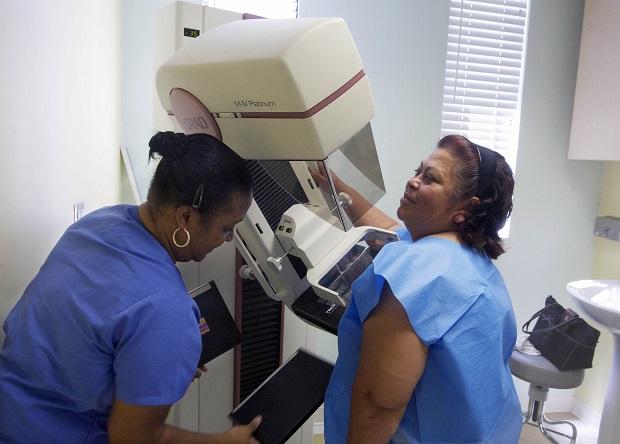New data on breast, ovarian cancer highlight age risks

In this May 6, 2010 file photo, detection lead mammographer, Toborcia Bedgood, left, prepares a screen-film mammography test for patient Alicia Maldonado, at The Elizabeth Center for Cancer Detection in Los Angeles. AP
WASHINGTON, United States — Researchers unveiled new data Tuesday that they said would help better assess breast or ovarian cancer risks in women, identifying the advantages of early detection and lifelong monitoring.
The study, published in the Journal of the American Medical Association (JAMA), involved nearly 10,000 women with the most common mutations — 6,036 with BRCA1 and 3,820 with BRCA2.
Of those surveyed, 5,046 had no cancer at the beginning of the study, while 4,810 had either a breast or ovarian tumor.
During a median follow-up period of five years, 426 women were diagnosed with breast cancer, 109 with ovarian cancer and 245 with contralateral breast cancer.
The absolute risk of breast cancer between the onset of adulthood and age 80 was 72 percent for women with the BRCA1 mutation and 69 percent for those with the BRCA2 mutant gene.
But the incidence of breast cancer increased rapidly in early adulthood until the ages of 30 to 40 for BRCA1 mutation carriers and until the ages of 40 to 50 for those with the BRCA2 mutation.
Beyond 40 years and 50 years respectively, the incidence of cancer in those surveyed remained unchanged until 80 years.
The absolute risk of ovarian cancer up to 80 years of age was 44 percent in the BRCA1 mutation group and 17 percent in the BRCA2 mutation group.
For contralateral breast cancer, the risk accumulated for 20 years after the diagnosis of cancer in the other breast, was 40 percent for women with the BRCA1 mutation and 26 percent for those with BRCA2.
Women with BRCA1 and BRCA2 mutations are likelier still to develop breast cancer if their relatives — of first and second degree of kinship — have had cancer, said the study’s authors, led by Antonis Antoniou at the University of Cambridge in Britain.
The risk of cancer also varies according to the site of the mutation on the BRCA1 or BRCA2 genes.
“The results indicate that family history is a strong risk factor for mutation carriers and that cancer risks vary by mutation location, suggesting that individualized counseling should incorporate both family history profiles and mutation location,” the authors said.
The results can be used to estimate more precisely the risk of breast and ovarian cancer, and to determine at what age to start regular screening.
The number of breast cancer cases in the United States in 2017 is estimated at 252,710 including 40,610 deaths, according to the National Cancer Institute (NCI). CBB